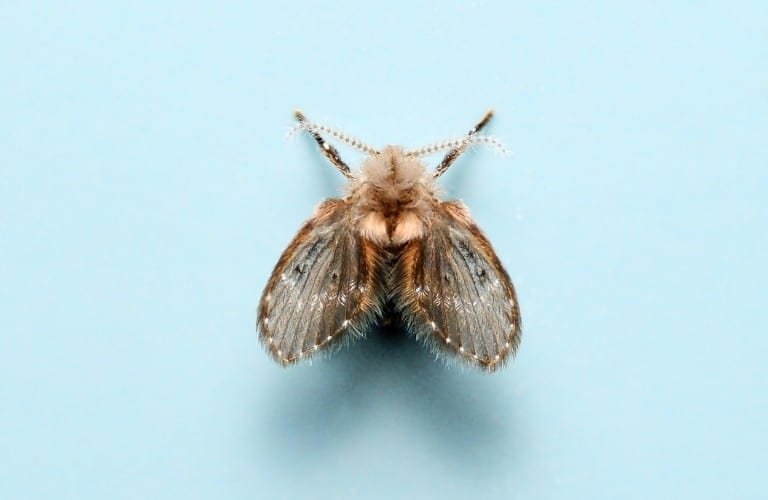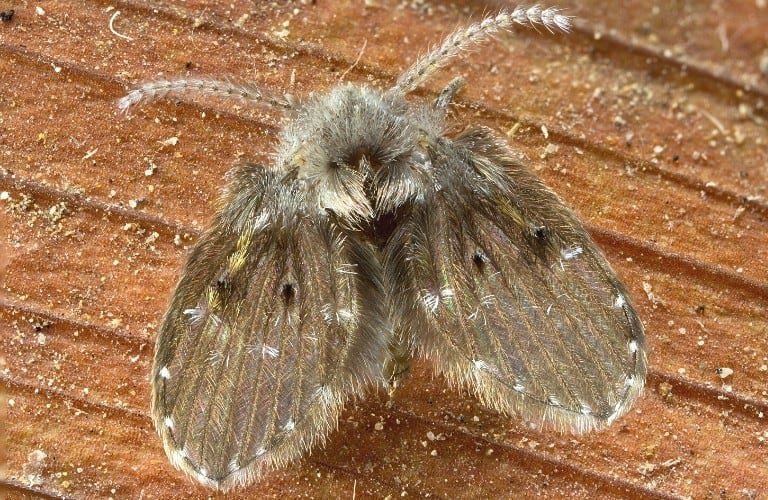Basements and garages are havens for a variety of bugs. If you have a sump pump in one of these places, you might notice tiny little bugs hopping around.
Can drain flies come from the sump pump? Drain flies can often be found living and breeding in sump pumps, particularly the pit area, because they are attracted to places with plenty of standing water and decaying organic material. To eliminate them, thoroughly clean the sump pump pit often.
In the following, you’ll learn more about drain fly behavior and find a detailed, step-by-step guide for cleaning out your sump pump to eliminate the current problem and prevent future infestations.
What Are Drain Flies?
Drain flies, also known as moth flies, sink flies, and sewer flies, are part of the group generally known as “gnats.”
Learn how to tell the difference between drain flies and another very common household gnat, the fruit fly, here.
These bugs are not venomous and do not carry disease. However, they are considered a nuisance when they infest in large numbers.
They are anywhere from 1 to 5 millimeters long and appear to be covered in fur. The name “moth flies” comes from their disproportionately large wings.
They don’t fly long distances with these wings, however, preferring instead to only go short distances.
This gives the impression that they are hopping or jumping through the air instead of flying.
In addition to their long, broad wings, these bugs also have long antennae that allow them to feel their way in the darkness.
This is important because drain flies prefer to live in dark, damp areas.
They enjoy environments like the inside of sink, shower, or tub drains as well as other pipes and plumbing systems.
These plumbing systems are where drain flies can find their primary means of nourishment: decaying organic matter.
Things such as human sweat, dead skin, and food remnants can often be found in drains.
Drain flies also feed on human and animal feces, rotting fruit, and decaying plants.
For a complete description of what causes drain flies to appear in your home, read this article.
The film that develops on top of stagnant water in pipes is the perfect place for drain flies to lay their eggs and breed.
In fact, drain flies breed incredibly quickly. An adult female drain fly can produce up to 300 offspring in 48 hours!
This makes it difficult to stop a drain fly infestation, because each adult you see probably means there are countless young gnats that you can’t see.
However, drain flies have a short life cycle. The typical drain fly only survives up to 24 days and is not very hardy.
Be sure to check out our Complete Drain Fly Elimination Guide to learn the best prevention practice, eradication methods, and key tips.
What Is a Sump Pump?
A sump pump is a machine that gets rid of water that has collected in an unwanted area.
Sump pumps are most often found in basements but are also installed in garages and other areas prone to standing water.
The pump is generally automated to turn on whenever a certain amount of water collects in the tank.
Then, when the pump is activated, it carries the water away from the house to an acceptable location.
Because of the potential for standing water in the sump pump’s tank, there is always a chance drain flies will congregate.
How to Keep Drain Flies Out of the Sump Pump
1. Drain the Pit
Automatic sump pumps only trigger when the water has reached a certain level. Thus, if there is only a small amount of water in the pit, the pump will not turn on.
That small amount of water can still attract drain flies if left stagnant for too long.
If this is the case with your sump pump, turn on the pump manually. Hopefully, the water will then be taken away from the pit.
If your sump pump is broken, contact a professional plumber or electrician to take care of the issue.
In the meantime, use a wet vacuum cleaner, a bucket, or a towel to dry up the standing water.
2. Clean the Pit
Use soap, warm water, and a long-handled brush to thoroughly clean the pit. The goal is to remove any film or decaying organic matter in the pit so that drain flies’ food is eliminated.
Also make sure to eliminate any drain fly larvae that you see.
Larvae look like pale, translucent, flattened cylinders that stick to the sides or bottom of the pit. They also usually have black heads.
Use the soapy water and brush to unstick them from the surface.
Because of environmental concerns, do not use pesticides in this step. Do not contaminate the water or the sump pump with harmful chemicals.
If the pump is working and you’re satisfied that the pit is clean, rinse the soapy water out with clean, warm water. Allow the pump to suck the rinse out and away.
If the pump isn’t working, use a damp cloth to wipe the soap away.
Then, dry it with another cloth as best as you can. Set up floor fans to help dry the pit quickly.
3. Use an IGR
An Insect Growth Regulator (or IGR) is a light pesticide that kills young insects. It is not powerful enough to kill adults, so it is considered safer than a full-strength pesticide.
It penetrates the protective shell of the larvae and eggs to stunt the young bugs’ growth. Even if the eggs eventually hatch, they will not survive.
Try an IGR like the ZOECON Gentrol Insect Growth Regulator, which is an aerosol that you can spray around the pit.
Any larvae that were not eliminated by your cleaning will be affected. Additionally, any larvae that are laid after the application will be stunted.
4. Kill Adult Drain Flies on Sight
When you see a drain fly outside of the sump pit, kill it immediately. Use a fly swatter or tissue, then clean up the body.
This steady attack will slowly but surely reduce the number of drain flies in your basement or garage.
Consider using one of the traps for adult drain flies that we recommend in our article “Best Trap for Drain Flies” for a more hands-off approach to killing adults.
You might not immediately notice any changes in the number of drain flies near your sump pump, but rest assured that they will quickly die off if you follow these steps.
Can Drain Flies Come From the Toilet?
Drain flies in your bathroom most likely come from your shower, sink, or tub drain. However, they can occasionally come from your toilet.
(See our complete guide to removing a drain fly infestation centered around your toilet.)
If the toilet has not been flushed in a few months or longer, the stagnant water might have created a film on which the drain flies can lay their eggs.
The first step is to look in the toilet tank and bowl areas to see if there are any visible drain flies or larvae.
If there are, turn off the water to the toilet and flush it several times (until there is no more water in the tank or bowl).
Then, carefully clean the tank or bowl. For the tank, use a mild cleaner, such as dish soap, to avoid damaging the porcelain. Wipe it down with a sponge or rag.
For the bowl, simply use a typical toilet bowl cleaner, preferably one with bleach, and toilet brush. Make sure to reach up under the rim, where larvae could have been laid.
Most likely, if you’ve determined that they’re coming from your toilet, they’ve made their home in the closet flange.
The closet flange is the place where the toilet connects to the plumbing. The flange is a waxy ring that acts as a gasket, sealing the toilet to the pipe.
To access it, you must remove the toilet from its moorings (find instructions here). Once you’ve carefully removed the toilet, clean the flange thoroughly.
Use a paint stirrer or scraper to reach down into the pipe as far as you can, removing any filmy or gelatinous buildup on the sides of the pipe.
In order to kill the larvae, you will need more than just normal water flushed through the toilet. Instead, boil half a gallon of water and add a cup of white vinegar to it.
Pour the hot water down the pipe, letting the strength of the vinegar kill the larvae.
For a particularly bad infestation, use a product such as Natural Armor Fruit and Drain Fly Killer.
This all-natural pesticide coats the inside of your pipes with a thick, clinging gel, killing adult and baby drain flies on contact.
It’s completely safe for all drains, pipes, septic systems, and toilets.
Conclusion
If you see small dark bugs hopping in the air around your sump pump, there is a good chance that they are drain flies.
Sump pumps — and, more specifically, sump pits — are attractive to drain flies because of the standing water that can often be found there.
To get rid of them, dry and clean the pit thoroughly, use an insect growth regulator, and kill adults when you see them.
Unfortunately, sump pumps and toilets are not the only places you’ll find drain flies reproducing in your home.
Visit all our drain fly articles (access them here) to learn where you’ll likely find infestations and the most effective measures to take to get rid of them and prevent future problems.





